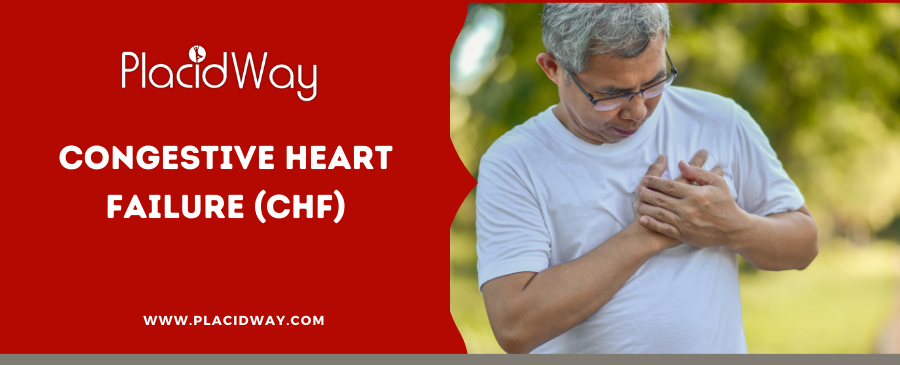
Table of Content
Key Insights at a Glance
- The treatment approach for CHF abroad often includes advanced cardiac therapies not readily available in all countries.
- Costs for CHF treatment can vary significantly, with options abroad potentially offering savings of up to 50% compared to U.S. prices.
- Complications from CHF treatments can include risks such as kidney damage or heart rhythm problems.
- Internationally accredited hospitals abroad offer high standards of care with state-of-the-art facilities.
- Patients choosing treatment abroad should consider the travel requirements and potential need for follow-up care.
What is Congestive Heart Failure (CHF)?
Congestive Heart Failure (CHF) is a chronic progressive condition that affects the pumping power of your heart muscles. While often referred to simply as "heart failure," CHF specifically involves the stage where fluid builds up around the heart and causes it to pump inefficiently.
Symptoms of Congestive Heart Failure
- Shortness of breath during activity or while resting.
- Swelling in legs, ankles, and feet.
- Fatigue and weakness.
- Rapid or irregular heartbeat.
- Persistent cough or wheezing with white or pink blood-tinged phlegm.
Latest Types of CHF Treatments Available Worldwide
| Treatment | Description | Availability |
|---|---|---|
| Medications | ACE inhibitors, beta-blockers, diuretics, etc. | Widely Available |
| Device Implantation | Pacemakers, defibrillators | Select Countries |
| Surgical Procedures | Coronary artery bypass grafting (CABG), Heart valve repair or replacement | Advanced Medical Centers |
For different packages for CHF treatments, click here.
Safety Concerns for CHF Treatment Overseas
- Ensuring the facility is internationally accredited.
- Understanding the potential risks and complications associated with treatment.
- Arranging for follow-up care upon return to home country.
- Considering travel insurance that covers medical treatments abroad.
Benefits of CHF Treatment Abroad
- Access to specialized treatments not available locally.
- Cost-effective options for high-quality treatment.
- Opportunity to recover in a vacation-like environment.
Risks Associated with CHF Treatment Globally
- Risk of infection from surgical procedures.
- Potential complications from heart devices.
- Challenges with post-treatment follow-up remotely.
Procedure Details for CHF Treatment
| Step | Description |
|---|---|
| Initial Consultation | Assessment of heart function and overall health. |
| Treatment Planning | Choosing the appropriate treatment modality based on condition severity. |
| Implementation | Administering treatment, whether medication, device implantation, or surgery. |
Cost of CHF Treatment in the World | Compare Prices
| Country | Cost |
|---|---|
| Mexico | $8,000 - $12,000 |
| Turkey | $10,000 - $15,000 |
| Thailand | $9,000 - $14,000 |
| Colombia | $7,500 - $11,000 |
| India | $6,000 - $10,000 |
| Austria | $15,000 - $20,000 |
| USA | $20,000 - $30,000 |
| UK | $18,000 - $25,000 |
Find prices for CHF treatment near you here.
FAQs Related to CHF Treatment Overseas
What does the CHF treatment cost without insurance?
The cost of CHF treatment without insurance can vary greatly depending on the country and the specific treatments required. Typically, costs can range from $6,000 to $30,000.
What are the success rates for CHF treatment abroad?
Success rates for CHF treatment abroad can be very high, especially in facilities that specialize in cardiac care, with many reporting improvement in patient symptoms and reduced hospital readmissions.
How long does recovery take?
Recovery time after CHF treatment can vary; medications may require ongoing management, while surgical recovery could take weeks to months, depending on the procedure's extent.
Are there language barriers in medical facilities abroad?
Many top medical facilities catering to international patients have multilingual staff to assist with communication, reducing the language barrier.
What should I consider when choosing a country for CHF treatment?
Consider factors such as the quality of cardiac care, costs, travel logistics, and whether the country has facilities with international accreditations.
Book Your CHF Treatment Abroad with PlacidWay
Choose from a variety of accredited hospitals around the world, tailored specifically to your health needs and budget. With PlacidWay, you can ensure high-quality care and a seamless treatment journey abroad. Start your path to heart health recovery today!
Heart Surgery Abroad, Cardiac Care Abroad










Share this listing